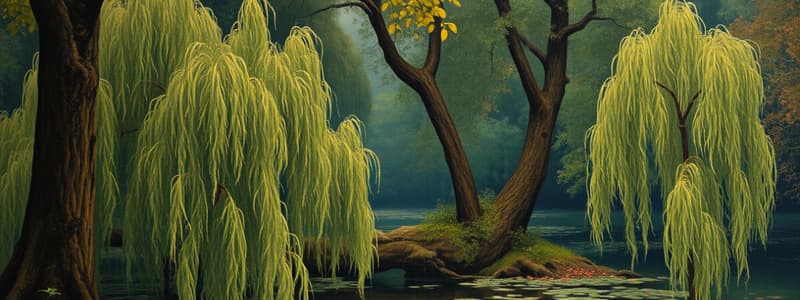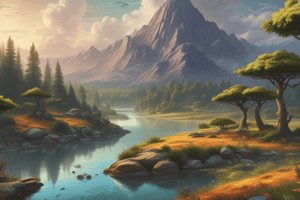Podcast
Questions and Answers
What is a defining characteristic of aquatic biomes?
What is a defining characteristic of aquatic biomes?
- They are primarily composed of terrestrial vegetation.
- They exist only in polar regions.
- They can be categorized into freshwater and marine ecosystems. (correct)
- They are characterized only by rivers and lakes.
Which of the following vegetation types is most commonly found in temperate forests?
Which of the following vegetation types is most commonly found in temperate forests?
- Cacti and succulents.
- Only coniferous species.
- Tropical hardwoods like mahogany.
- Deciduous trees like oak and maple. (correct)
Which of these climates is typical for desert ecosystems?
Which of these climates is typical for desert ecosystems?
- High humidity with frequent rainfall.
- Mild temperatures year-round with rich undergrowth.
- Low precipitation and extreme temperature variations. (correct)
- Consistent temperatures and abundant water sources.
Which of the following best describes the biodiversity of temperate forests?
Which of the following best describes the biodiversity of temperate forests?
Which of the following can be classified as a terrestrial biome?
Which of the following can be classified as a terrestrial biome?
Flashcards are hidden until you start studying
Study Notes
Types of Biomes
- Terrestrial Biomes: Land-based ecosystems characterized by climate, vegetation, and animal life.
- Examples include forests, deserts, grasslands, tundras.
- Aquatic Biomes: Water-based ecosystems, categorized into freshwater and marine.
- Freshwater: lakes, rivers, ponds.
- Marine: oceans, coral reefs, estuaries.
Characteristics of Temperate Forests
- Location: Found in temperate regions with distinct seasons.
- Climate: Moderate climate with seasonal temperature variations; adequate rainfall (75-150 cm/year).
- Vegetation: Deciduous trees (oak, maple) and some coniferous species; rich undergrowth.
- Biodiversity: Supports a wide variety of wildlife including mammals (deer, bears), birds, and insects.
Desert Ecosystems
- Location: Found globally; characterized by low precipitation (<25 cm/year).
- Climate: Extreme temperature variations; hot days and cold nights.
- Vegetation: Sparse vegetation; cacti and succulents dominate.
- Wildlife: Adapted species (lizards, snakes, rodents) with specialized behaviors for water conservation.
Aquatic Biomes
- Freshwater Biomes:
- Include lakes, rivers, ponds, and wetlands.
- Support species like fish, amphibians, aquatic plants, and microorganisms.
- Marine Biomes:
- Include oceans, coral reefs, and estuaries.
- High biodiversity; essential for global climate regulation.
- Coral reefs: diverse ecosystems, requiring warm, shallow waters.
Rainforests
- Types: Tropical and temperate rainforests.
- Climate: High rainfall (200-450 cm/year); warm temperatures year-round.
- Biodiversity: Extremely high; home to numerous species, including unique plants and animals.
- Stratification: Multi-layered structure (emergent, canopy, understory, forest floor).
Taigas (Boreal Forests)
- Location: Found in northern regions, covering parts of Canada, Europe, and Asia.
- Climate: Long, cold winters and short, cool summers; moderate precipitation.
- Vegetation: Dominated by coniferous trees (spruce, fir, pine).
- Wildlife: Adapted species like moose, wolves, and various birds; hibernation and migration patterns.
Tundras
- Location: Found in polar regions and high mountains.
- Climate: Cold, harsh conditions; short growing seasons with minimal precipitation.
- Soil: Permafrost layer inhibits root growth; soil is nutrient-poor.
- Vegetation: Low-lying plants (mosses, lichens, small shrubs).
- Wildlife: Species adapted to cold; includes caribou, arctic foxes, and migratory birds.
Grasslands
- Types: Temperate grasslands (prairies) and tropical grasslands (savannas).
- Climate: Moderate rainfall (25-75 cm/year); characterized by hot summers and cold winters (temperate) or warm year-round (tropical).
- Vegetation: Dominated by grasses; few trees or shrubs due to periodic fires and grazing.
- Wildlife: Large herbivores (bison, zebras) and predators (wolves, lions); important for biodiversity.
Types of Biomes
- Terrestrial Biomes: Ecosystems based on land, influenced by climate, vegetation, and animal life, including forests, deserts, grasslands, and tundras.
- Aquatic Biomes: Water-based ecosystems, divided into two main categories:
- Freshwater: Includes lakes, rivers, and ponds characterized by low salt content.
- Marine: Encompasses oceans, coral reefs, and estuaries, characterized by higher salt concentrations.
Characteristics of Temperate Forests
- Location: Typically found in temperate regions that experience four distinct seasons.
- Climate: Features a moderate climate with seasonal temperature changes and adequate rainfall ranging from 75 to 150 cm annually.
- Vegetation: Dominated by deciduous trees like oak and maple, mixed with some coniferous species, and supports a rich undergrowth.
- Biodiversity: Home to diverse wildlife including mammals such as deer and bears, various bird species, and numerous insects.
Desert Ecosystems
- Location: Present globally across various continents; marked by extremely low precipitation.
- Climate: Characterized by harsh conditions, including high temperatures during the day and cooler nights.
- Vegetation: Adapted plant life, including cacti and succulents, designed to conserve water.
- Animal Life: Wildlife adapted to arid conditions, with strategies for water conservation and extreme temperature tolerance.
Studying That Suits You
Use AI to generate personalized quizzes and flashcards to suit your learning preferences.




